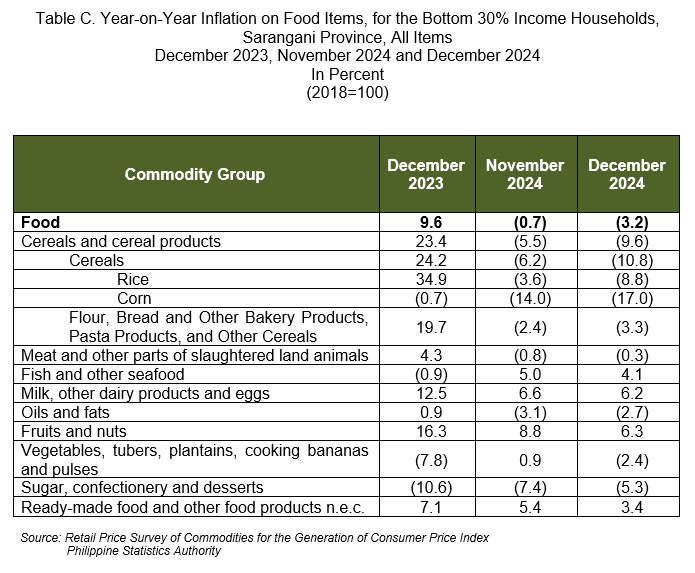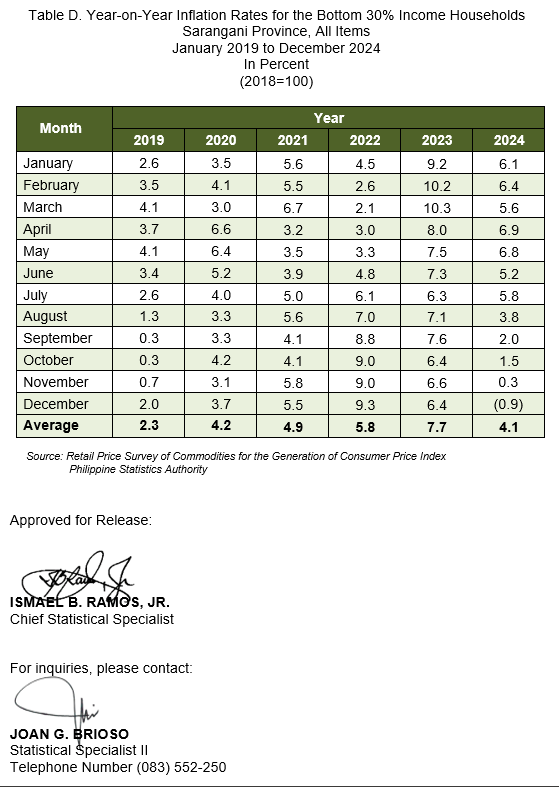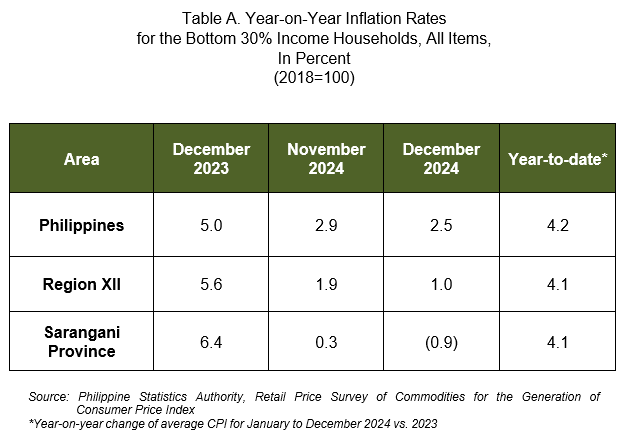
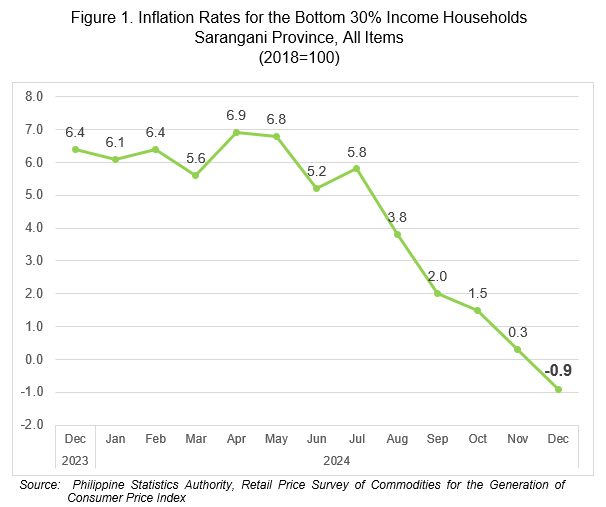
A. Sarangani Province
1. Overall Inflation
The province’s inflation rate for the bottom 30% income households posted a decline of 0.9 percent in December 2024 from 0.3 percent in November 2024. In December 2023, inflation rate was higher at 6.4 percent. (Figure 1, Tables A and B)
1.1 Main Drivers to the Downward Trend of the Overall Inflation
The main driver to the downward trend of the overall inflation for this income group in December 2024 was the slower annual increment in the index of food and non-alcoholic beverages with -2.8 percent from -0.5 percent in the previous month. This was followed by housing, water, electricity, gas and other fuels at 0.6 percent during the month from 0.7 percent in November 2024. Also, furnishings, household equipment and routine household maintenance contributed to the downtrend at 0.7 percent in December 2024 from 0.8 percent in the previous month.
In contrary, the following commodity groups registered higher inflation rate for the bottom 30% income households during the month:
a) Alcoholic beverages and tobacco, 3.4 percent from 2.6 percent;
b) Transport, 2.4 percent from 0.9 percent; and
c) Personal care and miscellaneous goods and services, 4.6 percent from 4.5 percent. (Table B)
The following are the indices of the rest of commodity groups that retained their respective previous month’s inflation rates in December 2024:
a) Clothing and footwear, at 1.5 percent;
b) Health, at 1.7 percent;
c) Information and communication, at 0.4 percent;
d) Recreation, sport and culture, at 3.8 percent;
e) Education services, at zero inflation;
f) Restaurants and accommodation services, at zero inflation; and
g) Financial services, at zero inflation. (Table B)
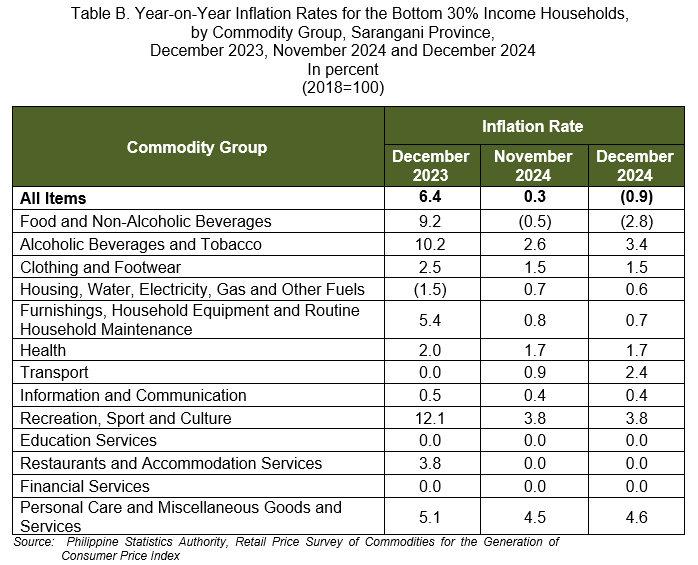
1.2 Main Contributor to the Overall Inflation
The food and non-alcoholic beverages with 168.4 percent share or -1.5 percentage points, was the top contributor to the December 2024 overall inflation for the bottom 30% income households.
2. Annual Average Inflation
The province’s annual average inflation rate for 2024 stood at 4.1 percent, which was lower than the 2023 annual average inflation rate of 7.7 percent.
2.1 Main Drivers to the Downward Trend of the 2024 Annual Average Inflation
The downtrend in the 2024 annual average inflation for the bottom 30% income households in General Santos City was primarily caused by the lower annual average increase in the index of food and non-alcoholic beverages at 5.6 percent in 2024 from 11.0 percent annual average inflation in 2023. This was followed by alcoholic beverages and tobacco at 4.8 percent in 2024 from 11.6 percent annual average inflation in 2023. Also contributed to the downtrend was the lower annual average inflation of personal care and miscellaneous goods and services at 4.4 percent in 2024 from 8.0 percent annual average inflation in 2023.
Moreover, the following commodity groups also registered a lower annual average inflation for the bottom 30% income households in 2024 compared with 2023:
a. Clothing and footwear, 1.2 percent from 4.3 percent;
b. Furnishings, household equipment and routine household maintenance, 2.1 percent from 6.7 percent;
c. Health, 1.6 percent from 2.6 percent;
d. Information and communication, 0.4 percent from 1.6 percent;
e. Recreation, sport and culture, 6.7 percent from 9.2 percent; and
f. Restaurants and accommodation services, 0.6 percent from 3.5 percent;
On the contrary, the following commodity groups posted higher annual average inflation in 2024:
a. Housing, water, electricity, gas and other fuels, 0.3 percent from -0.2 percent;
b. Furnishings, household equipment and routine household maintenance, 2.9 percent from 0.4 percent;
Furthermore, the indices of financial services retained its annual average inflation at zero inflation in 2024.
3. Food Inflation
Food inflation for the bottom 30% income households in Sarangani posted a further decline of 3.2 percent in December 2024 from -0.7 percent in the previous month. In December 2023, food inflation for the bottom 30% income households in the province was higher at 9.6 percent.
3.1 Main Drivers to the Downward Trend of the Food Inflation
The deceleration of food inflation for the bottom 30% income households in December 2024 was due to the slower annual increment of rice with -8.8 percent from -3.6 percent in the previous month. This was followed by vegetables, tubers, plantains, cooking bananas and pulses at -2.4 percent inflation during the month from 0.9 percent in November 2024. Also, corn contributed to the downtrend with -17.0 percent in December 2024 from -14.0 percent in the previous month. (Table C)
In addition, slower food inflation was also recorded in the following indices:
a) Flour, bread and other bakery products, pasta products, and other cereals, -3.3 percent from -2.4 percent;
b) Fish and other seafood, 4.1 percent from 5.0 percent;
c) Milk, other dairy products and eggs, 6.2 percent from 6.6 percent;
d) Fruits and nuts, 6.3 percent from 8.8 percent;
e) Ready-made food and other food products n.e.c., 3.4 percent from 5.4 percent. (Table C)
In contrary, the following indices registered higher food inflation rate for the bottom 30% income households during the month:
a) Meat and other parts of slaughtered land animals, -0.3 percent from -0.8 percent;
b) Oils and fats, -2.7 percent from -3.1 percent; and
c) Sugar, confectionery and desserts, -5.3 percent from -7.4 percent. (Table C)
3.2 Main Contributors to the Food Inflation
Food inflation contributed 178.8 percent or -1.6 percentage point to the December 2024 overall inflation for this particular income group. The top three food groups in terms of contribution to the food inflation during the month were the following:
a. Cereals and cereal products, which includes rice, corn, flour, bread and other bakery products, pasta products, and other cereals, with 134.7 percent share or -4.3 percentage point;
b. Vegetables, tubers, plantains, cooking bananas and pulses, with 6.5 percent share or 0.2 percentage point; and
c. Sugar, confectionery and desserts, with 4.6 percent share or 0.2 percentage point.
3.3 Annual Average Food Inflation
In 2024, the annual food inflation rate in Sarangani Province for the bottom 30% income households was observed at 5.8 percent, lower than the recorded annual average food inflation rate at 11.2 percent in 2023.
